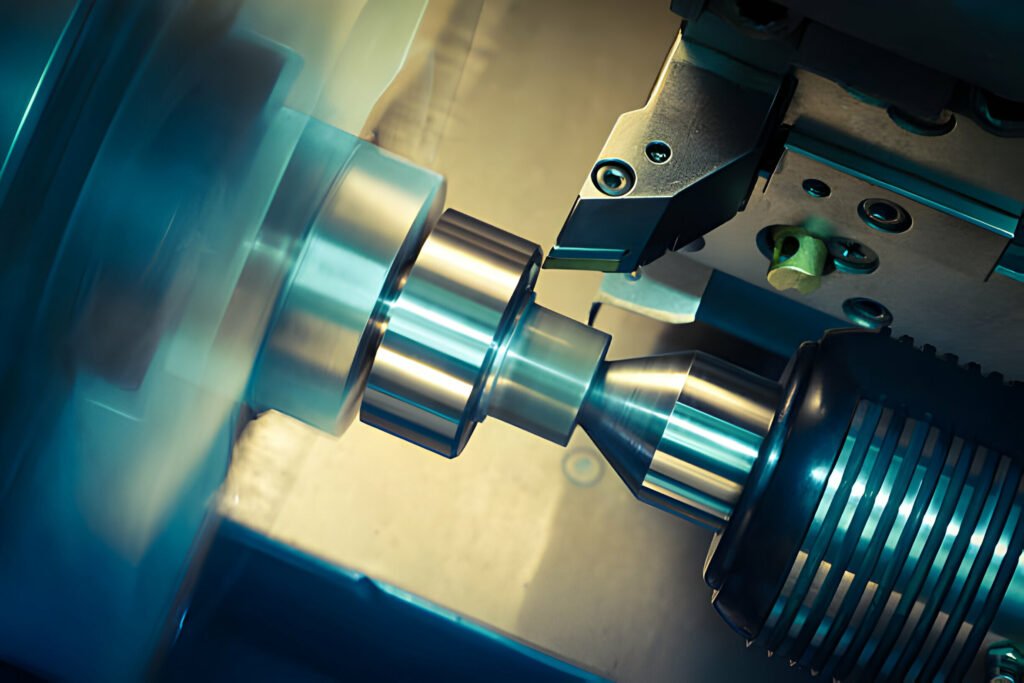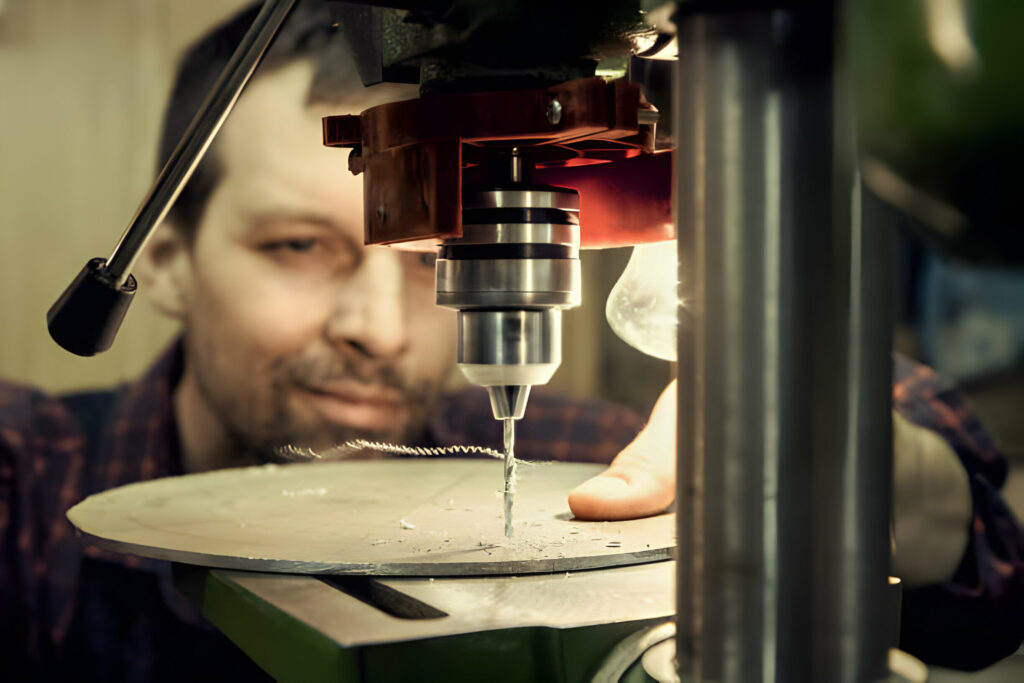A unique kind of computer-controlled manufacturing known as multi-axis CNC machining allows machine tools to move cutters and parts in several directions.
Three axes of motion are available to regular CNC machines: side to side, up and down, and back and forth. But multi-axis machines can move in four or more axes. This gives them superpowers! With the extra motion, multi-axis machines can cut shapes that would be impossible on three-axis machines.
Things like aeroplane wings and jet engine parts need complex curves and angles that are hard to make otherwise. Industries like aerospace, cars, and medical equipment use multi-axis CNC all the time.

The machines let them build very complicated designs with tight tolerances needed for those products.
What is Multi-axis CNC Machining? An Overview
Multi-axis CNC machining lets machines cut in more ways than before. Usually, machines can only cut back and forth, up and down, and side to side – that’s 3 axes. But multi-axis machines can cut in 4 or more axes. This gives them superpowers!
The extra moving ways mean tools and parts can be put in many positions. Then, machines can shape objects with tricky designs. Things like aeroplane parts need shapes that are hard to make otherwise. Industries that need exact parts always use multi-axis CNC.
Car companies and medical equipment makers use it, too. Multi-axis machines let them build complex designs that regular 3-axis machines couldn’t handle as well.
How Does Multi-axis CNC Machining Work?

Here is an accessible explanation of how multi-axis CNC machining works:
- Design and Programming:
The process starts by designing the part using computer-aided design (CAD) software before programming via computer-aided manufacturing (CAM). After finishing this step, CAM provides instructions regarding toolpaths, speeds, and feeds necessary for milling it out of solid material.
- Machine Setup:
While setting up the CNC machine with all necessary cutting tools, fixtures, and work-holding devices (clamping/fixtured parts), stability must also be ensured during the machining process.
- Toolpath Generation:
The CAM software produces toolpaths based on instructions programmed into it by users. These toolpaths define precise movements and orientations of cutting tools used for material removal from workpieces.
- Machining Process:
A CNC machine executes toolpaths generated by its programmed instructions, with the cutting tool moving along multiple axes simultaneously by programmed instructions. Rotary axes enable rotation and tilting of cutting tools, enabling complex shapes and features to be machined more precisely than ever.
- Continuous Monitoring:
During machining, sensors and feedback mechanisms continuously track parameters such as tool wear, cutting forces and dimensional accuracy to help optimise and ensure quality control. This data allows companies to streamline operations while upholding quality assurance standards.
- Finishing Operations:
Following initial roughing cuts, the machine may perform additional finishing operations as requested for that part. Depending on its requirements, these could include contouring, drilling, tapping, or surface finishing operations.
What are the Different Axes in CNC Machines?
CNC machines can have various axes of movement, which determine the direction the cutting tool or workpiece can move. The number and types of axes depend on the specific machine and its configuration. Here are the primary axes commonly found in CNC machines:
- 3-Axis CNC Machining
The X-axis moves the tool left and right like a seesaw. The Y-axis slides it backward and forwards like a window opening and closing. The Z-axis lifts the cutting bit up and down just like an elevator.
These three simple motions let machines cut straight shapes quickly and easily. However, the 3-axis is limited – it can only carve flat or at 90-degree angles.
The movements are essential like a back-and-forth knife slice. While efficient, the 3-axis struggles with curves and complex bends.
- 4-Axis CNC Machining
With four available motions now, this machine gets sneakier! It has the standard X, Y, and Z functions but adds an A-axis, too.
This fourth rotation point twists and turns the toolpost or stock. So drills can burrow at slants and edges can be bevelled on an angle. Parts achieve a tapered twist.
4-axis machines blend the slicing of 3-axis with a blending and stirring action. Products get shapes beyond straight lines thanks to the axle that arcs and pivots material in new ways.
- 5-Axis CNC Machining
This full-fledged kitchen has five cooking movements. Identical to the 4-axis, it has X, Y, and Z linear functions and an A-axis spin. However, the addition of the B-axis gives total tilt-and-swirl flexibility.
B rotates parts smoothly through a complete 360. Now, complex surfaces like double curves can be machined with an even wrap. By independently pivoting around two tilt axes, every workpiece’s nook and contour is within reach of the endmill or laser.
5-axis truly sets fabrication free – there’s no shape it can’t configure with the right synchronised movements across its full range of motion.
- 6-Axis CNC Machining
A 6-axis CNC machine builds on the capabilities of the 5-axis by adding one more rotational axis, called the C-axis.
With 6 total axes of movement controlled by the CNC system, the workpiece can be spun entirely in any direction relative to the cutting tool. Products like ergonomic handles and medical implants with complex contours can be fully machined in one setup.
The sixth axis allows machinery to cut deeply sculpted shapes and openings that would be inaccessible with only 5 axes by rotating the part continuously during machining operations.
- 7-Axis CNC Machining
Taking multi-axis machining one step further, the 7-axis CNC introduces a seventh rotational axis called the E-axis.
This additional axis allows the twisting motion of the entire toolhead assembly, providing even more possibilities for orienting the cutting tool in the workpiece’s hard-to-reach areas.
Finely detailed molds, prototypes, and aerospace components are machined using 7-axis capabilities. With seven independent and synchronised movements, even minuscule interior features can be cut precisely due to the high skill and positioning flexibility afforded by this type of advanced computer numerical control system.
- 8-Axis CNC Machining
An 8-axis CNC machine is a unique dual setup that employs two independent 4-axis machines working in tandem to manipulate the part from opposite directions control simultaneously. This doubles the number of movements controllable compared to a single 4-axis unit.
Through redundancy and fully rotational cutting from both faces, incredibly complex jet engine and turbine components can be produced to rigorous tolerances and tight clearances.
The dual 4-axis configuration allows complete machining of interior and exterior surfaces in a single loading of the part blank.
- 9-Axis CNC Machining
A 9-axis machine combines the capabilities of a standard 5-axis mill with a 4-axis turning centre integrated into a single CNC system.
With 9 controllable axes, parts can be roughed, finished, and customised without reclaming or machine changes. Medical implants with intricate inner bores and outer contours are well-suited to the streamlined, high-precision 9-axis process.
Complex geometries demanding both milling and turning operations are efficiently produced.
- 12-Axis CNC Machining
A 12-axis CNC machine utilises a dual 6-axis head configuration to represent the pinnacle of multi-axis technology. Each independent cutting head functions as an individual 6-axis unit, controlled simultaneously by a single controller and program.
This delivers an incredible twelve independent and synchronised movements between the two heads. Previously unattainable part shapes can be cut, carved, and molded to highly tight tolerances across all interior and exterior surfaces.
Rocket components, aerospace alloys, and specialty customised designs benefit most from 12-axis machining centre flexibility and control.
Benefits of Multi-axis Machining
Multi-axis CNC machining brings tremendous advantages over traditional 3-axis technology. By controlling 4, 5 or more axes simultaneously, multi-axis machines unlock huge gains in efficiency, precision, and design freedom. They allow manufacturers to produce far more complex parts without compromising quality or productivity. Some of the key benefits of multi-axis machining include:
- Increased efficiency:
With multi-axis capabilities, complex parts can be machined completely in a single setup rather than multiple setups on 3-axis machines. This eliminates non-cutting time spent changing tools and fixtures and reloading parts between operations. It allows one-touch production for highly intricate components.
- Enhanced precision:
Multi-axis control provides greater positioning accuracy of the cutting tool relative to the workpiece. Robust tolerance features like complex internal bores can be machined through independently controlled axes without compromise. Precision is maintained across Freeform surfaces in hard-to-reach areas, which is impossible on standard 3-axis machines.
- Reduction in cost and time:
The streamlined one-touch multi-axis machining processes reduce overall manufacturing time and costs. Less manual labour is required for setup and inspection when parts can be roughed and finished together. Cycle times are shorter when rework is minimised. This higher throughput lowers per-unit production costs significantly.
- Expanded design possibilities:
Multi-axis freed designers from the limitations of 3-axis milling. Previously infeasible geometries can now be machined and tested, unlocking innovation. Complex contours on jet engines, medical implants, and other high-value components have become viable design options.
- Improved tool life:
Strategic axis motions allow tools to remain engaged in the material cut. This helps reduce breakage compared to retracting/reinserting on 3-axis machines, which increases tool life and lowers associated costs.
- Reduced scrap and material waste:
With the above benefits, less rework and fewer rejected parts are produced. This decreases wasted materials, energy costs, and environmental impact from disposed production waste. Less work-in-progress inventory also reduces capital tied up incomplete components.
- Streamlined manufacturing processes:
Integration of setups shrinks factory space needs. Higher automation and flexible multi-axis centres allow smaller production lots to be handled more efficiently for custom parts and special alloys. The manufacturing process becomes leaner.
How to Choose a Multi Axis CNC Machine? Steps You Need to Know
Choosing a multi-axis CNC machine requires careful consideration of various factors to ensure it meets your specific requirements and production needs. Here are some critical steps to help guide you in the selection process:

- Needs assessment: Evaluate current and future part volumes, geometries, and tolerances to match machine capabilities. Consider machine shop resources and training requirements.
- Axis configurations: Choose an optimal number of axes for part complexity from 5 to 9+ depending on machining needs. Simultaneous or live tooling may help.
- Machine size and capacity: Select work envelope, maximum part size, and weight capacity suitable for most significant components. Ensure adequate table space for fixtures.
- Machine construction and rigidity: Modular or cast iron designs provide thermal stability and structural integrity for tight-tolerance work. Rigid, heavy builds prevent vibration-related issues.
- Control system and software: Interface, programming format, and CAD/CAM integration determine ease of use. Closed/open architecture impacts upgrades and third-party add-ons.
- Tooling and work holding: Assess fixture and clamping options. Automatic tool changers streamline setups. Live tooling expands multi-tasking capabilities.
- Support and service: Consider response time, spare parts availability, training programs, service contracts, and upgrade support for long-term requirements.
- Budget and ROI: Analyse total investment versus potential increased throughput and profits over time to justify purchase—financing options help.
- Recommendations and reviews: Consult experienced machinists and recent case studies for unbiased models to investigate. Demo the same make/model if possible.
- Demonstrations and quotes: Hands-on trials and detailed price breakdowns validate accuracy, uptime claims, and total cost of ownership projections.
Conclusion
In conclusion, multi-axis CNC machining unlocks incredible design possibilities for complex parts across many industries. With 4, 5, or more axes controlled simultaneously, there are virtually no geometric limits to the shapes that can be produced.
By optimising the positioning of cutting tools, multi-axis takes machining precision, productivity, and flexibility to an entirely new level.
At Rootech, every great product starts with a great idea. Why not let our expertise help you build the next breakthrough invention? Get in touch to discuss how our multi-axis capabilities can accelerate your innovative ideas.



